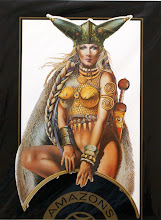Luis Bermejo was born Luis Bermejo Rojo in Madrid in 1931, although the family soon moved to Albacete. It was in Albacete that Bermejo began his professional career, still in his teens, as an assistant to Manuel Gago, himself only in his early twenties but already recognised as a great talent in Spanish comics. Gago had published his first comic strip in 1942 and quickly found work with Editorial Valenciana, drawing for the series Niño Gonzalo and Richard y Bakutu.
In 1944, Gago created El Guerrero del Antifaz [Warrior of the Mask], which would run for 668 issues, finally ending in 1966. Bermejo began as a letterer on the series in 1947 but, before long, was allowed to ink pages. With Gago’s aid, Bermejo launched his own series in 1948, creating El Rey del Mar [The King of the Sea] for Editorial Valenciana. Written by one of the top scriptwriters of the era, Pedro Quesada, it ran for 46 issues, over which time Bermejo began to assimilate influences other than Gago, notably Alex Raymond.
Bermejo’s comic work diversified. In 1949 he drew “Diablillos” [Mischief] for Chicos and, a couple of years later, “Polín, Poli y Pol-Pol” for the same paper; he drew similarly humorous strips for girls for the woman’s magazine Mariló.
Bermejo returned to Madrid to attend the Academy of Fine Arts at San Fernando, studying under illustrator Carlos Sáenz de Tejada. Bermejo’s schooling meant that a more realistic style and better figurework were on display in over 100 episodes of Aventuras del FBI [Adventures of the FBI], created for Madrid-based Editorial Rollán in 1951, following the successful launch of a series of novels with the title “FBI” a year earlier. The strip, following the adventures of FBI agent Jack Hope, is considered a classic in Spain, ran for years and the episodes drawn by Bermejo were recycled in the 1960s and 1970s, and later available in a complete collection.
Bermejo moved to Valencia and collaborated with a number of top Spanish writers, including Miguel González Casquel (one of the scriptwriters of Aventuras del FBI), with whom he created Sigur (1954) and “Federico Trotamundos” for Chicos (1955) and Pedro Quesada on the juvenile adventure series Roque Brío (1956). The latter was an unexpected failure, lasting on 8 editions, but the two teamed up again for episodes of Pantera Negra [Black Panther], launched in 1956 with artwork by José Ortiz and, later, Miguel Quesada, Manuel Gago’s brother-in-law who had worked with Bermejo in the 1940s.
Bermejo had by now established himself at Editorial Maga, working closely with Gago, Miguel and Pedro Quesada and José and Leopoldo Ortiz. Here he produced his second famous work, Apache, scripted by Pedro Quesada, which he drew for over 50 issues from 1958.
Bermejo was already in demand elsewhere, having produced his first strip for the British market via the agency A.L.I. in 1957—an issue of Super Detective Library featuring private eye Tod Claymore. Bermejo also contributed romance stories to Mirabelle, Romeo and Cherie in 1957-60. At the same time, he was still a busy artist in Spain, working for Bruguera on a series of literary adaptations: “La conquista de los poles”, “Un yanqui en la corte del Rey Arturo” (both published in 1957), “Una vida aventurerea” (1958), “Las aventuras del Club Pickwick” and “Las aventuras de Pinocho” (both 1959).
In 1960, Bermejo began drawing the character John Steel for Super Detective Library. The early stories were fairly commonplace war stories with Steel as a wartime agent for Military Intelligence. But when the stories switched to Thriller Picture Library, Steel was given a make-over and began featuring in a series of jazz-age, crime noir private eye yarns with Bermejo the main artist.
Contributions to War Picture Library, Battle Picture Library, Air Ace and Commando in 1960-62 firmly established Bermejo in the UK and he went on to draw “Mann of Battle” for Eagle (1962) and a series of stories featuring maritime adventurer Pike Mason in Boys’ World (1963-64).
To cope with the workload, Bermejo often worked with Matías Alonso, the main artist on Gago’s “El Guerrero del Antifaz” since 1961, and the two worked on a number of projects for Editorial Maga, including Marco Polo (1963), Vida y costumbres de los Vikingos (1965) and África y sus habitantes (1966). At the same time, Bermejo was having his biggest success in the UK when he worked on “Heros the Spartan” for Eagle, alternating adventures with Frank Bellamy in 1963-66.
Bermejo now had an informal studio set up, working with José Ortiz, Leopoldo Ortiz, Juan González Alacreu, Alfredo Sanchis Cortés and Emilio Frejo, their work agented by Bardon Art in the UK and by Pierro D’Ami in Italy. The Bermejo studio was responsible for many strips in the UK, notably “UFO Agent” in Eagle (1966) and “The Avengers” in Diana (1966-67).
Bermejo, solo, drew “The Missing Link” for Fantastic in 1967-68 and contributed illustrations to Tell Me Why, Look and Learn and Once Upon a Time, also painting the long-running fairy tale Princess Marigold for Treasure (1969-71).
Bermejo was a popular contributor to James Warren's horror magazines Vampirella, Creepy and Eerie in 1975-79, notably drawing "The Rook". In 1979-81, he drew an adaptation of Lord of the Rings which was published throughout Europe. He subsequently produced episodes of Storia Del West, drew "The Fox" for Vampirella and other for Warren. The recovering Spanish market also meant regular work in Cimoc, Metropol, Baladin, Hunter, Zona 84 and other magazines, as well as adapting books by Isaac Asimov and A. E. Van Vogt.
He worked on the revival of the famous adventure strip "El Capitán Trueno" [Captain Thunder] in 1986, but turned to painting and was able to retire from comics in the early 1990s.
Examples of artwork by Luis Bermejo can be found for sale at the Illustration Art Gallery.
Subscribe to:
Post Comments (Atom)





















No comments:
Post a Comment